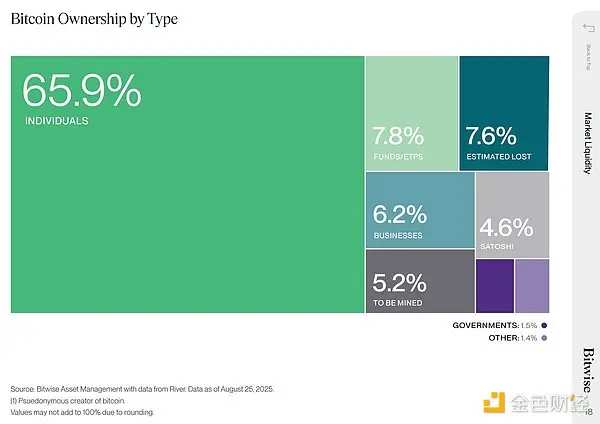Institutions Already Control 12.5% of Bitcoin? Bitwise Report: This Wealth Transfer Is Just the Beginning
According to Bitwise's quarterly market report, the Bitcoin market is undergoing a "great wealth transfer" from early retail investors to institutional investors (such as funds and exchange-traded products), corporations, and government entities. The key highlights of the report are as follows:
-
Rising institutional ownership: Institutional investors currently control approximately 12.5% of the Bitcoin supply, and this proportion is rapidly increasing. In comparison, institutional ownership of traditional assets (such as Treasury ETFs and S&P 500 ETFs) is generally higher, indicating that Bitcoin’s institutional adoption is still in its early stages.
-
Retail dominance persists: About 66% of Bitcoin remains in the hands of non-institutional investors, but liquidity is limited—with only 14.5% of Bitcoin stored on exchanges, while the rest is largely held long-term, requiring significant price increases to incentivize early holders to sell.
-
 Changing demand dynamics: Data from 2025 shows that institutional demand for Bitcoin has reached approximately seven times the supply gap caused by halving events. The influence of halving events on market cycles has diminished, with macro factors (such as global growth expectations and monetary policy) now driving price volatility.
Changing demand dynamics: Data from 2025 shows that institutional demand for Bitcoin has reached approximately seven times the supply gap caused by halving events. The influence of halving events on market cycles has diminished, with macro factors (such as global growth expectations and monetary policy) now driving price volatility. -
Evolving cycle patterns: Over 80% of Bitcoin price fluctuations are driven by macro factors. Future bull and bear cycles are expected to align with macroeconomic/business cycles rather than being dominated by halving events.
The report concludes that Bitcoin will need to reach levels far above its current price to complete the wealth transfer, and the influx of institutions is transforming it into a true "macro asset."

This data clearly reveals prevailing trends and can even explain the distinctiveness of the current Bitcoin cycle (data provided by River).
1. Interpretation of the essence of the "great wealth transfer"
The key point lies in: $Bitcoin (BTC.CC)$ It is transitioning from early retail investors to institutional investors (funds/Exchange Traded Products), corporations, and even government entities.
Unlike other traditional asset classes in history, Bitcoin's path to popularity began with retail investors such as cypherpunks and early adopters, followed by the initial involvement of institutional investors like family offices, fund managers, and ETFs.
Even today, retail investors still account for approximately 66%, meaning that the vast majority of Bitcoin remains controlled by non-institutional investors (refer to the matrix distribution in the chart above)! In contrast, the latest data from the U.S. 13F filings show that traditional asset classes have a significantly higher allocation by institutional investors.
Observing the institutional holdings in mainstream traditional financial ETFs:
-
iShares 20+ Year Treasury Bond ETF (TLT) institutional holdings 79%;
-
SPDR S&P 500 ETF (SPY) institutional holdings 58%;
-
SPDR Gold Shares ETF (GLD) institutional holdings 36%.
In contrast, Bank of America’s latest survey of global fund managers shows that the average allocation to crypto assets (including Bitcoin and other tokens) is only 0.4%. (Supplement: The current institutional holding ratio of IBIT is only 26%...)
This demonstrates that, as the industry often says, “We are still in the early stages,” and institutional adoption is still in its infancy.
However, it is undeniable that a large-scale wealth transfer from retail to institutional investors is underway. The migration of wealth from early retail holders to institutional investors will bring about multiple impacts, the depth of which may be beyond imagination:
2. Bitcoin Adoption: Trends and Cyclical Patterns
(1) Trend
First, it is important to clarify: this transition will not happen overnight but is a long-term trend.
The reality is that the majority of Bitcoin remains illiquid, being held for the long term. Only about 14.5% of the Bitcoin supply is stored on exchanges like Coinbase or Binance, where it has relatively higher liquidity. The remaining assets are kept in off-chain wallets, remaining non-liquid.
Without economic incentives, the redistribution of Bitcoin wealth will not occur automatically.
Many early holders have set psychological price targets (e.g., $1 million per BTC) or economic objectives (e.g., 'funding for property purchase') as triggers for selling their Bitcoin. These targets are significantly higher than the current market price of approximately $115,000. To attract these illiquid tokens into the market (i.e., exchanges), the price of Bitcoin would need to rise substantially.
In this process, as ETFs hold assets in trust for millions of individual investors, Bitcoin's adoption will broaden. Corporate earnings reports also indicate that it is being held by hundreds of thousands of diverse investors. As of the writing of this article, institutional investors (ETPs and publicly traded companies) have already controlled approximately 12.5% of the Bitcoin supply—and this figure continues to grow rapidly.

(2) Cyclical Patterns
Most analysts may agree: the early bull and bear cycles of Bitcoin were primarily driven by the halving events that occur every 210,000 blocks (approximately every four years). This mechanism reduces the production of new Bitcoin by half (hence the term 'halving').
However, the impact of these halving events is diminishing with each occurrence—both in absolute terms and relative to the circulating supply. With increasing institutional adoption and evolving demand structures, the influence of halving events has notably weakened.
Data from 2025 shows that institutional demand has reached approximately seven times the supply gap caused by the halving!

In this process, the influence of traditional macroeconomic cycles has relatively increased – Bitcoin has become a true "macro asset."
Our quantitative analysis also indicates that over 80% of Bitcoin's price volatility in the past six months was driven by macro factors such as global growth expectations and monetary policy, with token-specific factors contributing less than 5%.
However, the dominance of macro factors implies that future bull and bear cycles of Bitcoin will fluctuate in sync with macro/business cycles, rendering the four-year cycle driven by "halving" likely ineffective.
This ultimately suggests that the accumulation and distribution of Bitcoin will depend on the prevailing macro environment (expansion/boom versus contraction/recession), thereby triggering short-term price fluctuations in risk-on/risk-off patterns.
3. Conclusion
The fundamental implication of the "great wealth transfer" is that the price of Bitcoin needs to reach much higher levels – far above current levels – to incentivize further adoption and facilitate the transition from early retail investors to institutional investors.
The continuous influx of institutional investors signifies that Bitcoin has become a true "macro asset," indicating that future bull and bear cycles will increasingly be dominated by macro/business cycles rather than halving events.
Editor/Doris
Content Original Link:
" target="_blank">

































































